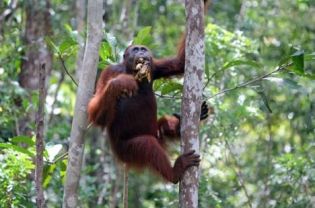Students at Kutai Kartanegara University in East Kalimantan have rescued an endangered orangutan adopted by a local family after being driven out of its habitat by a palm oil company, Jakarta Globe reported news.
Ryo Aditya, the head of the university’s nature club, Wamapal, said on Monday that the three-year-old female ape was reported to have been kept by the residents of Panca Raya village in Kutai Kartanegara district for three months.
“They found her in the backyard of their home. That area is now an palm oil plantation, but it used to be an orangutan habitat,” he said.
He added that the family kept the orangutan in a cage but otherwise treated and fed her well.
Wamapal plans to hand over the orangutan to district wildlife officials, who are expected to give the animal to conservationists at the Samboja Lestari orangutan rehabilitation center, from where she will eventually be released back into the wild.
“This is the second time that we’ve rescued an orangutan being kept in captivity,” Ryo said.
“The last time was in 2007, when we found an orangutan in a residential area and handed it over to the authorities.”
He added that the actual number of orangutans being kept as pets by residents was high and on the rise, given the rate at which the animals were being driven out of their natural habitats by companies clearing the region’s forests for palm oil plantations and coal mines.
The Forestry Ministry previously noted that 70 percent of the wild orangutan population in Kalimantan lived outside protected areas.
The Borneo Orangutan Survival Foundation, which runs the Samboja Lestari facility near Balikpapan, plans to build another rehabilitation center in North Penajam Paser district as part of efforts to speed up the release of all rescued orangutans back into the wild by 2015.

